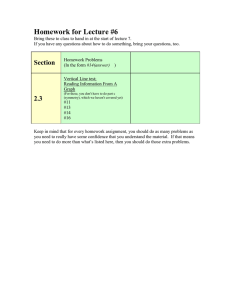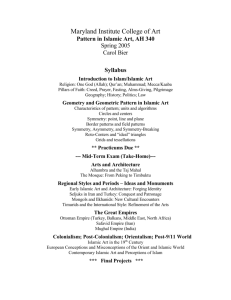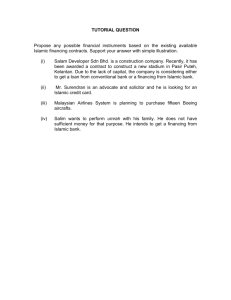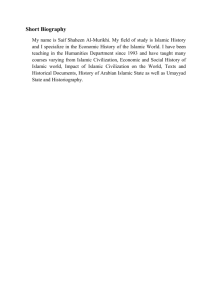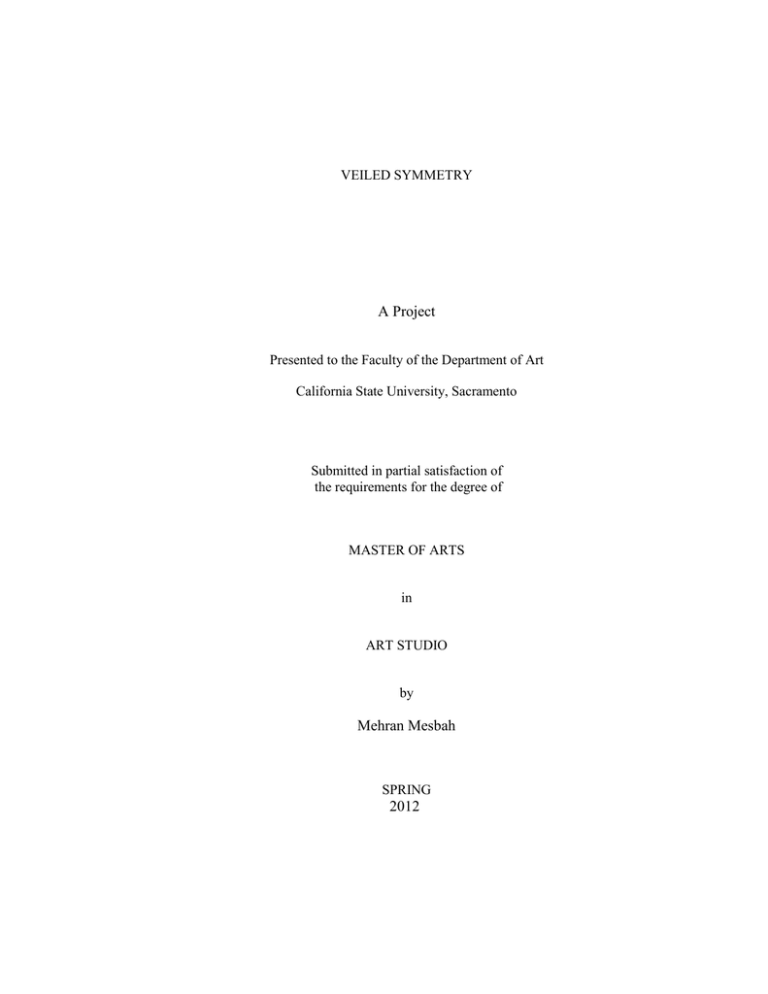
VEILED SYMMETRY
A Project
Presented to the Faculty of the Department of Art
California State University, Sacramento
Submitted in partial satisfaction of
the requirements for the degree of
MASTER OF ARTS
in
ART STUDIO
by
Mehran Mesbah
SPRING
2012
© 2012
Mehran Mesbah
ALL RIGHTS RESERVED
ii
VEILED SYMMETRY
A Project
by
Mehran Mesbah
Approved by:
__________________________________, Committee Chair
Andrew Connelly
__________________________________, Second Reader
Sarah Flohr
____________________________
Date
iii
Student: Mehran Mesbah
I certify that this student has met the requirements for format contained in the University format
manual, and that this project is suitable for shelving in the Library and credit is to be awarded for
the project.
__________________________, Graduate Coordinator
Andrew Connelly
Department of Art
iv
___________________
Date
Abstract
of
VEILED SYMMETRY
by
Mehran Mesbah
Historically, Western and Islamic aesthetics alike derived from a desire to depict a
beauty which was absolute rather than relative. Each, however, have developed uniquely
different approaches to that end. Currently, these approaches seem to be locked in a
conflict of incompatibility. My work encourages a visual dialog between the two
contrasting perspectives. The following could be considered a guide for understanding
my motivation in creating a series of paintings titled Veiled Symmetry.
_______________________, Committee Chair
Andrew Connelly
_______________________
Date
v
TABLE OF CONTENTS
Page
List of Figures ........................................................................................................................ vii
INTRODUCTION .................................................................................................................... 1
CONFLUENCE: TWO COME IN ........................................................................................... 3
ISLAMIC PATTERN ............................................................................................................... 5
DIVERGENCE: ONE GOES OUT ........................................................................................ 10
ASSIMILATION: VEILED SYMMETRY ............................................................................ 14
A SPACE FOR CONVERSATION ....................................................................................... 16
HUMAN APPROPRIATION ................................................................................................. 18
CONCLUSION ....................................................................................................................... 21
Bibliography ........................................................................................................................... 23
vi
LIST OF FIGURES
Figures
Page
1.
Formation of the Circle .................................... .………………………………. 5
2.
Formation of the Triangle ..................................... ……………………………. 7
3.
Formation of the Hexagon ........... ………….…………………………………. 8
4.
Christ Pantocrator, 600-700 AD, encaustic on panel, Byzantine Period…… . 12
5.
Mehran Mesbah, Veiled Symmetry I, 2012, oil on wood panel, 44x47 in ........ 14
6.
Mehran Mesbah, Veiled Symmetry II, 2012, oil on wood panel, 44x47 in….…16
7.
Mehran Mesbah, Veiled Symmetry III, 2012, oil on panel, 44x47 in . ….……18
8.
Mehran Mesbah, Veiled Symmetry III, detail. … ……………………………. 19
vii
1
INTRODUCTION
And so in the Libyan fable it is told,
That once an eagle, stricken with a dart,
Said, when he saw the fashion of the shaft,
"With our own feathers, not by others' hands,
Are we now stricken".
-Aeschylus
Before entering into an examination of my painting series Veiled Symmetry, I’ve
chosen a poem, which illustrates a central preoccupation relating to my work. Once an
Eagle is derived from an Old Persian poem translated by the Greek playwright
Aeschylus. A simplistic portrayal, full of multifaceted implications relevant as much
then as it is today. The eagle struck by an arrow contemplates the alien penetration of its
flesh as originating from its own being. The affliction implies wounds not only of the
body, but more so of the mind. Too often the condition that facilitates basic human
reason is the same condition that leaves it incapacitated. This is a common human
conundrum. Over the course of millennia, this puzzle takes the contour of pattern. The
shapes of which are like footprints I follow in order to stumble upon a forward path.
In respect to pictorial history, it becomes increasingly difficult to distinguish
between arrows and eagles. More curious, the metaphor brings many questions to mind:
At what point does the eagle become arrow? Or even better: Are there still eagles or just
arrows? Post-Structuralist philosopher Jacques Derrida proposes an interesting
suggestion, referencing Michel de Montaigne, he writes, “we need to interpret
interpretations more than to interpret things” (Derrida 278). Returning to the previous
poem, the feather simultaneously represents the materiality of both objects. One could
2
consider the arrow as a reinterpretation of the eagle. Here, the irony becomes evident.
The reinterpretation kills the original. This is the eagle’s dying epiphany. Even more
humorous, it is also a Greek translation of a Persian poem. Nonetheless, it has survived
in this condition. And like the poem, my work holds the thing itself, the medium and
history of painting, suspended between two varying interpretations—a hybrid uniquely
my own. Moreover, Veiled Symmetry visually positions itself between the concerns of
both Western and Islamic aesthetics. Thus, in order to effectively communicate these
ocular ideas into words, I will utilize historical, religious, and philosophical perspectives
first, then excavate the meaning of the paintings visual attributes, and after include an
analysis of my own interpretation.
3
CONFLUENCE: TWO COME IN
A somewhat counterintuitive starting point in discussing a confluence of Islamic
and Western aesthetics can be located in Greek philosophy. Beginning with the former,
early Muslim scholars and theologians looked to Greek aesthetics as a foundation for
their visual literacy. David Wade, an artist, architect, and author specializing in Islamic
pattern, states that the absorption of Greek mathematical knowledge “is particularly
relevant to the evolution of Islamic geometric ornament, for the latter is essentially the
interplay of Platonic figures and proportions on the Euclidean plane. In fact these
configurations of straight lines and circles may be seen as an extension of the Platonic
search for a form of beauty that is not relative but absolute” (Wade 10). Allah, or “the
God” is absolute. He is omnipotent. He is one. He is everywhere. Based on this
description, how would one then depict Allah? It would seem as if words, like art, have
their limitations.
It is for these reasons Islamic aesthetics focus on mathematical abstraction rather
than figuration when describing the absolute. Luca Mozzati, an art historian specializing
in the art of Central Asia, says these distinctions influenced all facets of Islamic life
because, “as understood in Islam, the difference between the sacred and the profane is
flexible: everything is sacred, since everything derives from the will of God. Thus nature
cannot exist as distinct from God and no values exist that are not essentially religious”
(Mozzati 15). Having this understanding, it becomes increasingly clear that any Islamic
aesthetic must be articulated through its own vernacular. Thus the importance of
revelation, translated through the Prophet Muhammad, has generally manifested itself
4
through objects and nonrepresentational forms—visually evident in architecture,
ceramics, calligraphy, painting, and carpets to name a few. However, in regards to my
work, Islamic arabesques in particular have been the concentration of my visual interests.
Although some of the same principles could be applied to these other distinct features, a
closer examination of Islamic pattern should reveal their rich, complex pictorial
relevance.
5
Figure 1 Formation of the Circle
ISLAMIC PATTERN
More than a mere decorative motif, the rationale of Islamic arabesques is highly
symbolic. As a visual representation of something not presentable, these designs depict a
harmonious universe, articulated through geometry, and embodied through an array of
polygons or floral patterns. In accordance with the oneness and omnipresence of Allah,
this seemingly infinite expanse of space has an origin, represented by the point. Keith
Critchlow, a leading expert of sacred architecture and sacred geometry, has unique
insight pertaining to the symbolic nature of Islamic patterns. Speaking of this origin, he
6
writes, “The point of emergence does not necessarily reveal its causation either in the
field of its emergence or in the mind of the viewer. In the mind the point represents a
unitary focus of conscious awareness; in the physical world it represents a focal event in
a field which was previously uninterrupted” (Critchlow 9). The point has potential. It
creates something out of nothing. This creation will be the unseen intentionality by
which all other polygons locate themselves.
Upon having a point of reference, other relationships quickly solidify. As shown
in Figure 1, by connecting points equidistant from the center, a curvilinear line forms a
circle. Once the shape is connected, it creates a harmonious equilibrium between the two
relationships. To the Muslim, Critchlow explains, “the circle is not only the perfect
expression of justice—equality in all directions in a finite domain—but also the most
beautiful ‘parent’ of all the polygons, both containing and underlying them” (Critchlow
9). This brings us to the first polygon—the triangle. Referring to Figure 2, Critchlow
describes it as “the minimal expression of an area, and the simplest figure to which all
other polygons can be reduced. It is also symbolic of the minimal needs of consciousness
(i.e. Knower, Known, and act of Knowing), as well as the minimal description of the
basic biological needs: ingestion, absorption and excretion” (Critchlow 16). Lastly,
Figure 3 displays six circles rotating around a seventh, original circle at its center forming
the hexagon. These particular juxtapositions are not without meaning. As we will see
7
Figure 2 Formation of the Triangle
further on, though here Critchlow explains, “the centre circle loses none of its
significance as the fulcrum, but in this situation it becomes the balancing point between
manifestation below and metaphysical origins above, represented respectively by the
lower circle (the sensorial world and above as the upper circle (the world of being)”
(Critchlow 23). Moreover, the formation of these shapes, gives way to ideas, and these
ideas revert back to Greek mathematical geometry and even before.
8
Figure 3 Formation of the Hexagon
It could be said of all the varying polygons, the triangle and the hexagon retain
much of their religious significance. The Islamic study of Cosmology, in particular,
reinforced the reciprocal nature of the physical universe with the spiritual. Critchlow
clarifies that the significance of these shapes are not an isolated Islamic phenomena, but
complicit with two, major monotheistic religions. “Three gives rise to six, and six has a
vital role in Islamic cosmology as it does in the other two Abrahamic religions, Judaism
and Christianity; and that role relates to the number of days in which God created the
9
world. The Abrahamic wisdom insists that we regard the inner and outer meaning of this
cosmogony, the symbolic and literal dimensions. The six-pointed star is a symbol of
perfection in all three religions” (Critchlow 58). Here, the origin of these religious
positions presents a commonality, an interweaving of their reinterpretations.
These geometric forms when repeated as pattern become decorative but retain
their meanings as symbol. And as Critchlow so elegantly expounds, “Symbols can
exhaust verbal explanation but verbal explanation can in no way exhaust symbols…
Pattern like number, is one of the fundamental conditions of existence and is likewise a
vehicle of archetypes… These three basic shapes are used to symbolize the square of
earth or materiality, the triangle of human consciousness, and the hexagon (or circle) of
Heaven” (Critchlow 24). If we accept that “verbal explanation can in no way exhaust
symbols”, then it could be allowed that there exists a never ending cycle of their
reinterpretation. Moreover, as long as there is human cognition, symbols will be
continually reinterpreted ad infinitum.
DIVERGENCE: ONE GOES OUT
10
Now that a thorough investigation of a few, pivotal aspects of Islamic geometry
have emerged, let us examine a couple features of Western Aesthetic development.
Much like its Islamic counterpart, a distinct Christian aesthetic derived from the same
Greek philosophy. At this point I would like to direct my discussion towards a historical
significance where both perspectives overlap, then elucidate possible reasons why their
aesthetics diverged.
The beginnings of the Byzantine Empire affectively redirected Greek polytheism,
eroded by the Roman Empire, to a distinct Christian orientation. Similarly, the use of
images for spiritual purposes transferred, e.g. Greek/Roman gods to Jesus, Mary, the
Saints, etc., though it did not completely change in character. It was during this moment
in history that Mohammed would have his revelation. Robert Browning, a professor of
Ancient History and author of Byzantine culture, explains, “In the very year in which
Heraclius set out from Constantinople to destroy the Persian empire, Mohammed and his
followers migrated from Mecca to the safety of Medina, where the Prophet soon won
many new adherents and, more from necessity than from design, began to lay the
foundations of a Moslem Arab state. The success of the new movement was in large part
due to the weakness displayed by the two great empires, which for so long had confined
the Arabs to carrying out as auxiliaries the policies of others. Both Rome and Persia had
conquered and been conquered in turn, and now it was time for the Arabs to make their
own history. Within a few years of the death of Mohammed in 632, Moslem armies had
broken out of the Arabian Peninsula, invaded Roman and Persian territory, and begun the
career of conquest that in the course of a century was to take them to the banks of the
11
Loire in the west and the Indus in the east” (Browning 11-12). It was during this time I
consider the two aesthetics to be in closest proximity to each other, both historically, and
as I will explain, aesthetically.
The intimacy I wish to articulate between Christian and Islamic artistic practice at
this time is not necessarily visual, but more philosophical. The early Christian church
embraced Greek philosophical aesthetics, much like their Islamic complement, and
sought to describe the absolute over the relative. Constantine Cavarnos, an Art historian
on the Byzantine Empire, describes that “the Byzantines emphasized spirituality. By
covering up with clothes the anatomically distorted body, by the stiffness of the
representations, by the indifference to the ugliness of a person’s characteristic features,
the Byzantine painter accentuates ‘the inwardness of the representations and impresses
the spectator with the idea that these beings have forgotten their body….’ The icon
painter is not afraid to distort the natural proportions of the body, to exaggerate the size
of some parts and diminish that of others, because in this way he expresses inner
qualities. He is indifferent to the correct proportions of the body, to the outer form of
man, because he wants chiefly to represent the inner man. “The interest of the onlooker
is withdrawn from the body and focused on the face and especially on the eyes….’ Here
are expressed the virtues of meekness, humility, purity, spiritual love and wisdom, and so
on” (Cavarnos 64). Since Christianity during this time saw its Savior as both human and
divine, the figure, however distorted, remained. An early Byzantine example of this
bodily distortion has been provided in Figure 4. Christ Pantocrator reveals a shift in
12
aesthetics, which purposely abstracts the human form to emphasize the absolute over the
relative.
Figure 4 Christ Pantocrator, 600-700 AD, encaustic on panel, Byzantine Period
At this point it should be clarified that it would not always remain this way.
Slowly, over the course many centuries, Western Aesthetics began developing a secular
rather than religious character. This, however, would be too lengthy a topic to be
discussed in full here. So, for the purposes of this discussion, I will submit that Western
13
aesthetic philosophy evolved to question the very idea of the absolute. This new found
freedom allowed flexibility in content. Depictions of everyday objects and scenes began
to flood tableaux otherwise previously reserved for spiritual scenes. Even the idea of
representation was called into question through the Abstract Expressionist School. And
ironically enough, these two aesthetics again crossed paths in quality though from
complete opposite positions—one secular, the other religious.
Returning again to Once and Eagle, the metaphor could allude this divergence of
aesthetics to the fashioning of the arrow from the eagle—again, the interpretation of an
interpretation. Despite these inherent differences, to maintain a meaningful dialogue, one
must allow the other their line of thought. The modern, Western perspective that
questions the relevance and, or existence of God; and the Islamic perspective that
maintains that one can in no way separate the two, even when doubting or questioning its
very existence.
14
Figure 5 Mehran Mesbah, Veiled Symmetry I, 2012, oil on wood panel, 44x47 in
ASSIMILATION: VEILED SYMMETRY
Veiled Symmetry assimilates two distinct visual characteristics that can be found
in Western and Islamic art, respectively. At first glance, a six-point Islamic star pattern
dominates the space with its field and repetition. This pattern, typically flat, is rich in
15
complexity and symbolic meaning as discussed earlier. And second, as seen in Figure 5,
I utilized chiaroscuro techniques, exemplified by western painting traditions, to
illuminate the pattern with form, taking a resemblance of spiraling fluid. Moreover, by
distorting these patterns with a phenomenological event, I absolve the absolute of that
which it symbolizes, and the relativity in which it now stands. Comparatively dissimilar
to the Byzantine distortion of the figurative form, where the icon purposely abstracts the
physical to stress the spiritual. It is in this similar fashion that I have distorted pattern to
remind the spiritual of its humanity, of its relativity.
However, I have approached this sensitive position with reverence rather than
offence. For to the devout Muslim, figuration, when illustrating the divine, is not an
option. Once again, David Wade, an expert on Islamic pattern points out, “the making of
imitations of living beings is dangerously close to being in blasphemous competition with
Allah and the presumer may, according to another tradition, be required on the Day of
Judgement to breath life into his work and, failing, be condemned” (Wade 9). With this
consideration in mind, the distortions I have chosen are not figurative. They are
phenomenological. They are rooted in what the senses can perceive. They have no
breath of their own. They have the weight of gravity, and the fluidity of water. They, in
effect, mimic natural phenomena—all of which point to the same Greek philosophical
origin.
16
Figure 6 Mehran Mesbah. Veiled Symmetry II, 2012, oil on wood panel, 44x47 in
A SPACE FOR CONVERSATION
In order to provide a space for visual dialogue, a few, basic conditions are
beneficial for meaningful correspondence. First, placing the vast ideas presented by
Western and Islamic Aesthetics on the same playing field neutralizes their more obvious
17
disagreements, while strengthening areas of commonality. Second, they should be
equally represented. For example, in Figure 6 the various visually motifs i.e. the pattern,
and chiaroscuro effect partake of a dynamic yet even handed balance. And lastly, they
should have some metaphoric resemblance to each other, like the eagle/arrow relationship
in the poem Once an Eagle.
The eagle-arrow becomes the hinge, by which two stories intertwine.
Interestingly enough, Jacques Derrida refers to this ‘hinge’, if it can be called one, as a
monster. He writes, “A monster may be obviously a composite figure of heterogeneous
organisms that are grafted onto each other. This graft, this hybridization, this
composition that puts heterogeneous bodies together may be called a monster (Derrida
385). Although, on the other hand, he goes on to announce that the monster, once
encountered, “one begins to domesticate it, one begins […] to compare it to the norms, to
analyze it, consequently to master whatever could be frightening in this figure of the
monster. And the movement of accustoming oneself, but also of legitimization, and,
consequently, of normalization has already begun (Derrida 386). Here, I believe the
work begins to foster an environment which “interprets interpretations”, as Derrida has
suggested. However, I would include the interpretations of things as well, because a
thing as simple as a feather can serve as both lock and key to a multitude of
interpretations.
18
Figure 7 Mehran Mesbah, Veiled Symmetry III, 2012, oil on panel, 44x47 in
HUMAN APPROPRIATION
A reinterpretation can also be beautiful. If the appropriation seeks to develop
rather than destroy its predecessor. This idea could be seen as mutually beneficial for
both perspectives. Figure 7 visually attempts to do just that. The hexagon has been
19
replaced with the flat image of a boy and girl. A fascinating discovery that could be
“monstrous” can also be read as both pattern and figure. However, the figure also
contains a dimensionality of the five-pointed star, symbolic of humanity. Figure 8 is a
detail of Veiled Symmetry III. Here, the diamond formed triangles expose hexagons that
contain human pattern figures. This juxtaposition maintains both the hexagonal
connotation of perfection, and the pentagonal idea of humanity.
Figure 8 Mehran Mesbah, Veiled Symmetry III, detail
At this juncture, it could be said, is the fleeting moment where the eagle
contemplates the arrow. However, hopefully Veiled Symmetry has interwoven this
continuous metaphor with a positive outcome. Returning to Figure 8, it reveals a closer
look into the intermixing of human figure patterns. Through the distorting of the overall
20
pattern, each detail is of different size, value, and position in relation to the greater whole.
This variation could be thought as contingent with the reciprocal nature of the absolute
and the relative. A universal relativity grounded by humanity. However, each figure
poses a unique relation to the one next to it. These relations accumulate into a projecting
mass, which moves toward the viewer—extending an invitation to participate in the
visual dialog.
21
CONCLUSION
There is nothing to be known about anything except an initially large, and
forever expandable, web of relations to other things. Everything that can
serve as a term of relation can be dissolved into another set of relations,
and so on for ever. There are, so to speak, relations all the way down, all
the way up, and all the way out in every direction: you never reach
something which is not just one more nexus of relations.
-Richard Rorty
The main preoccupation of Veiled Symmetry revolves around the juxtaposition of
a few relations. Just as Richard Rorty, a modern, pragmatic philosopher, points out that
the “web of relations” will continue on in every direction and is inexhaustible. It is no
coincidence that I chose Islamic pattern as the ideal catalyst to both visually and
philosophically imbue the fractal quality of possible relations. For it has been my
lifelong pursuit to make interesting connections to ideas, to things, and now to
“interpretations”.
Islamic arabesques, full of symbolic meaning, simultaneously describe the
singular and the infinite. This encourages spectators to reflect on the absolute, rather than
the finite material world. On the other hand, western painting techniques also have an
intuitive quality that leaves the viewer in awe, reminding them of the medium’s
materiality but also their role as observer. These are two innate qualities in Veiled
Symmetry—intuition and reflection. The universe is big and our humanity small. I
believe at no time in our future history will we exhaust all of its possibilities. The only
22
unanswered riddle could be that our greatest potential has a relation to our most common
deficit—one where eagles become arrows.
23
BIBLIOGRAPHY
Aeschylus. “Once an Eagle” (translation from Persian), 525–456 B.C
http://www.bartleby.com/100/694.10.html
Browning, Robert. The Byzantine Empire, revised edition.
Washington, D.C: The Catholic University of America Press, 1980
Cavarnos, Constantine. Byzantine Thought and Art: a collection of essays.
Belmost, Mass.: Institute for Byzantine and Modern Greek Studies, 1968
Derrida, Jacques. Points…Interviews, 1974-1994. Trans. Peggy Kamuf, et al. Stanford:
Stanford University Press, 1995
Derrida, Jacques. Writing and Difference. Trans. Alan Bass
Chicago: University of Chicago Press, 1978
Mozzati, Luca. Islamic Art: Architecture, Painting, Calligraphy, Ceramics, Glass,
carpets / Luca Mozzati Trans. D. Radzinowicz … [et al.]
Munich; Berlin; London; New York: Prestel, c2010
Rorty, Richard. Philosophy and Social Hope.
New York: Penguin Books, 1999
Wade, David. Pattern in Islamic Art.
London: Studio Vista, 1976

